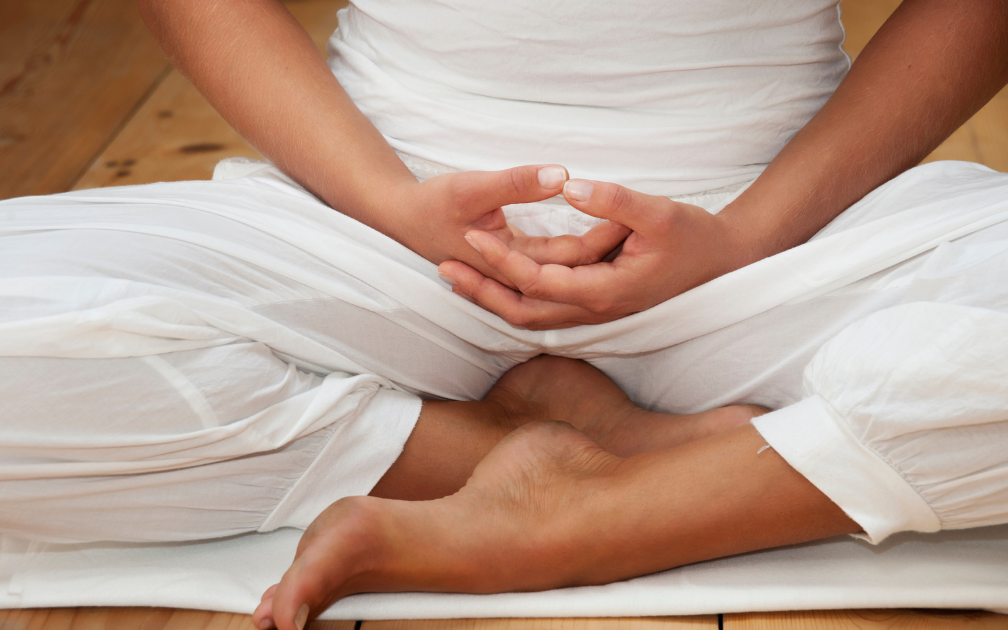Yoga, an ancient practice originating in India, is rapidly gaining worldwide popularity. One particular aspect of yoga is the Dhyana Mudra, a hand gesture that promotes deep concentration and offers numerous benefits. During yoga practice, we incorporate the Dhyana mudra to cultivate stillness in the mind, although achieving Dhyana itself is a challenging task. The term “Dhyana” derives from the combination of the Sanskrit words “DHI” and “YANA,” which collectively mean “to think” or “to perceive.” According to Patanjali’s Yoga Sutra, Dhyana represents one of the eight limbs of yoga.
This article discusses the Dhyana mudra and the benefits associated with this hand gesture in detail. Read on!

Meaning Of Dhyana Mudra:
The most common mudra used in meditation is the Dyani Mudra, symbolized by a chalice or bowl. This mudra represents the lower energetic storage center and the system of transmuting sexual energy. One of the key benefits of this mudra is its strong impact on the competence of the sacral chakra. When the chakra system is out of balance, the sacral chakra is often the first to suffer. An out-of-balance sacral chakra can manifest in various behavioral effects such as an inability to meet deadlines or fulfill responsibilities, leading to stress and anxiety. By diligently practicing the Dyani Mudra, improvement in the bowel and reproductive systems can be felt.
How to Do Dhyana Mudra (Samadhi Mudra):
By following these simple steps, you will be able to reap all the benefits associated with performing Dhyana Mudra:
- Start by sitting in sukhasana or padmasana with a straight spine and relaxed body.
- Place your left palm facing upwards on your lap.
- Position your right hand inside your left hand, with fingers fully stretched and aligned.
- Bring the thumbs of both hands together, creating a triangular shape, forming a mudra.
- Close your eyes gently and take deep, slow breaths.
- Maintain this seated posture for approximately fifteen minutes without moving.
- Slowly open your eyes after the duration and release the mudra.
- Practice this seated meditation regularly for a peaceful and calm mind.
Tips to Perform Dhyana Mudra:
Performing Dhyana Mudra can bring numerous benefits. To achieve this Mudra effectively, here are some useful tips:
- Chanting OM while holding your hands in Dhyana Mudra can enhance your level of awareness. The vibrations produced by chanting OM aid in concentration, allowing you to experience the full benefits of this Mudra.
- Combining Dhyana Mudra with pranayama (breath control techniques) can elevate the quality of your meditation. The synchronized practice of Mudra and pranayama deepens your focus and helps create a more profound meditative experience.
By incorporating these tips into your practice, you can optimize the effectiveness of Dhyana Mudra and enhance your meditation journey.
How Long Do You Hold Dhyana Mudra?
If you are a beginner, you can start with shorter sessions of 10 to 15 minutes each. It is recommended to practice Dhyana Mudra three times a day. As you progress, you can gradually increase the duration of your practice. Aim for about 45 minutes per day in a single session. It’s beneficial to distribute the practice throughout the day rather than doing it all at once. This gradual increase will help you build your concentration and meditation skills over time.
Benefits of Dhyana Mudra:
There are several benefits associated with the regular practice of Dhyana Mudra. Here are the few of them you can get with the gesture of meditation:
- Dhyana Mudra is a hand gesture designed for deepening meditation levels and aiding in the spiritual journey.
- It helps keep both sides of the brain and body active, enhancing mental alertness and sharpness.
- Dhyana Mudra promotes balance between the left and right regions of the brain and body.
- It assists in managing negative emotions like stress, depression, anger, and anxiety by keeping the mind calm and relaxed.
- Regular practice stimulates the Ida and Pingla Nadis, improving focus and attentiveness.
- Consistent practice of Dhyana Mudra can prevent mental and physical illnesses, promoting overall well-being.
- It enhances self-awareness, insight, and intuition on a spiritual level, aiding in deeper self-understanding.
- Incorporating Dhyana Mudra into your meditation practice offers numerous benefits for spiritual journey, mental health, and overall well-being.
- Overall, Dhyana Mudra is a powerful tool for enhancing meditation, achieving balance, and improving overall wellness.
Dhyana mudra is a hand gesture that promotes mental stillness and balance of the five elements in the body. It can be performed anytime and anywhere without limitations. By practicing Dhyana mudra, you can experience its numerous benefits. If you found this article helpful, please do not hesitate to let us know.
